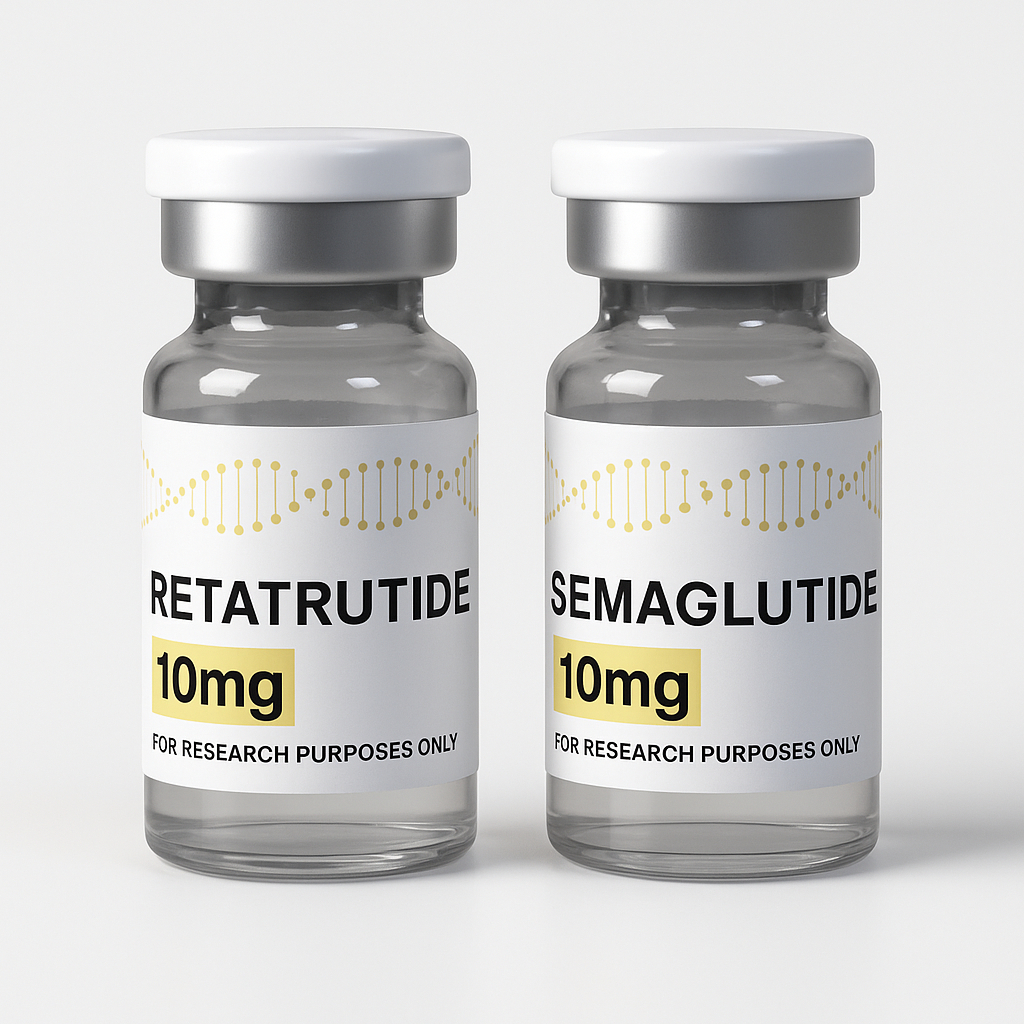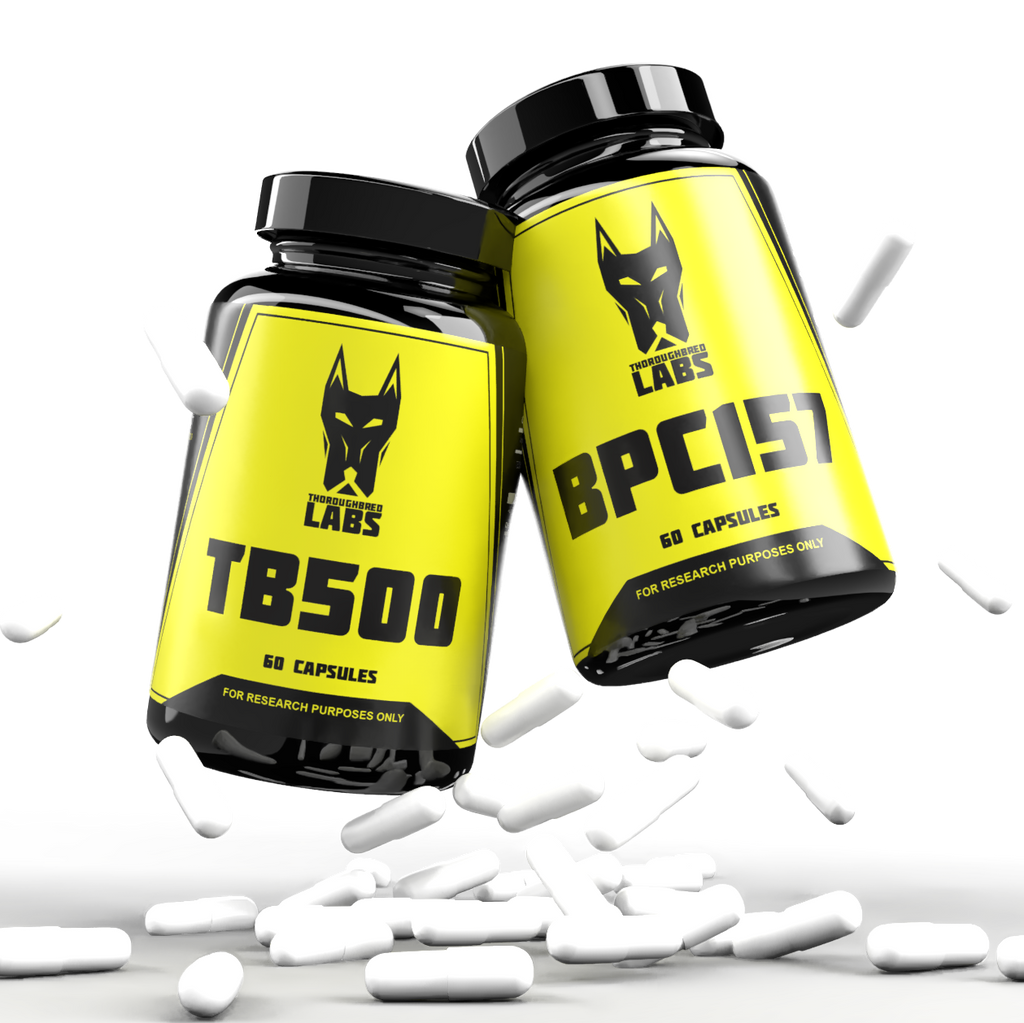Retatrutide vs Semaglutide: A Research‑Based Comparison

Background & Mechanism of Action
Semaglutide
-
Semaglutide is a glucagon‑like peptide‑1 receptor agonist (GLP‑1 RA). It acts by mimicking the hormone GLP‑1: augmenting glucose‑dependent insulin secretion, reducing glucagon secretion, slowing gastric emptying, and promoting satiety.
-
It is approved in many jurisdictions for type 2 diabetes (in lower doses) and for weight management (e.g. as Wegovy in many markets).
-
Clinical trials (e.g. STEP programs) have demonstrated substantial weight loss when used plus lifestyle therapy. PubMed+3JAMA Network+3JAMA Network+3
Retatrutide
-
Retatrutide is a triple agonist peptide that acts on three receptor axes: GLP‑1 receptor, GIP receptor (glucose‑dependent insulinotropic polypeptide), and glucagon receptor. PubMed+4PubMed+4Lilly Investor Relations+4
-
The rationale is that combining these hormonal pathways might lead to synergistic effects: suppressing appetite, improving insulin sensitivity, and (via glucagon receptor stimulation) increasing energy expenditure or fat oxidation. PubMed+4PubMed+4Elara+4
-
It is currently in clinical trials (phase 2 published, phase 3 in planning) and is not yet approved for medical use in humans. PubMed+4Lilly Investor Relations+4Lilly Investor Relations+4
Because semaglutide is established clinically and retatrutide is still investigational, much of the comparison is prospective or based on early data.
Efficacy: Weight Loss & Metabolic Effects
Semaglutide
-
In the STEP 3 trial, in adults without diabetes (≥ 8 weeks of low‑calorie diet + behavioral therapy), once‑weekly semaglutide 2.4 mg produced a mean weight loss of 16.0 % vs 5.7 % for placebo at 68 weeks. JAMA Network
-
In STEP 4, continuing semaglutide led to sustained and further weight loss (~17.4 % at week 68) vs those switched to placebo who regained; ~64 % of those continuing lost ≥ 15 %. JAMA Network
-
In earlier phase 2 dose-ranging trials, semaglutide doses produced weight loss in the range of ~11–14 % (versus placebo) over ~52 weeks. PubMed+2AJMC+2
-
Meta‑analyses and network meta-analyses generally place semaglutide among the more efficacious GLP‑1 RAs for weight loss. NCBI+1
-
Recent reports suggest even higher doses of semaglutide (e.g. a 7.2 mg dose) may push the average weight loss toward ~20.7 % in obesity trials. Reuters
Beyond weight loss, semaglutide has favorable effects on glycemic control, waist circumference, lipids, and cardiovascular risk in various studies. PubMed+4JAMA Network+4American College of Cardiology+4
Retatrutide
-
In a phase 2 trial of 338 adults (obese or overweight without diabetes), retatrutide showed dose-dependent weight loss: the highest dose (12 mg) gave a mean ~24.2 % weight reduction at 48 weeks. PubMed+4Lilly Investor Relations+4JAMA Network+4
-
Even at 24 weeks, high-dose groups saw ~17–18 % weight loss versus ~1.6 % in the placebo arm. (At 24 weeks, 12 mg dose group ~18 % reduction) PubMed+3JAMA Network+3Lilly Investor Relations+3
-
A Bayesian network meta‑analysis of GLP‑1, dual agonists, and retatrutide (19 RCTs, ~29,500 participants) found that retatrutide and dual agonists had equivalent mean weight loss (~ –11.0 kg), outperforming GLP‑1 RAs (~ –9.0 kg). For the ≥ 15 % weight‑loss outcome, retatrutide showed a particularly strong advantage (OR ~54.6). PubMed
-
A systematic review pooling multiple trials (n ≈ 1,082 participants across RCTs) found that the 12 mg dose of retatrutide drove the most robust reductions in body weight, BMI, and waist circumference. PubMed
-
Retatrutide also showed favorable impacts on lipid parameters: in a Phase II trial, non‑HDL cholesterol was reduced up to ~26.9 %, triglycerides and apoC-III levels dropped significantly, and the atherogenic lipoprotein profile improved. MedPath
-
In metabolic liver disease (MASLD, formerly NAFLD) settings, retatrutide reduced liver fat by ~43–82 % (depending on dose/time), and by 48 weeks up to ~86 % fat reduction in some participants, with 86 % reaching normalized liver fat (< 5 %). PubMed+3peptisearch.com+3PubMed+3
From these results, retatrutide is showing higher efficacy potential (in weight loss, fat mobilization, metabolic effects) compared to semaglutide, at least in the context of controlled trials. But these are early-phase data, so caution is needed.
One additional note: in the retatrutide phase 2 trial, weight loss was still trending downward at 48 weeks (i.e. no clear plateau yet), suggesting perhaps an extended therapeutic window. PubMed+3Lilly Investor Relations+3JAMA Network+3
Safety, Tolerability & Risks
Semaglutide
-
The most common side effects are gastrointestinal (GI) symptoms: nausea, vomiting, diarrhea, constipation, abdominal discomfort. These tend to occur early or during dose escalation. JAMA Network+3JAMA Network+3PubMed+3
-
In STEP 3, ~82.8 % of semaglutide participants had GI adverse events vs ~63.2 % in placebo; discontinuation due to adverse events was ~3.4 %. JAMA Network
-
Long‑term maintenance trial (STEP 4) suggested continued tolerability and persistence of benefit with ongoing use. JAMA Network
-
Because semaglutide is in clinical use, more data are available on rare adverse events, long-term outcomes, and real‑world safety.
-
A recent crowdsourced knowledge graph project using social media and FAERS data studied side effects of semaglutide across brands to supplement known safety profiles. arXiv
Retatrutide
-
The phase 2 trial reported a safety profile “similar to other incretin‑based therapies,” with gastrointestinal side effects being the most common (mild to moderate), especially during dose escalation. JAMA Network+3Lilly Investor Relations+3PubMed+3
-
In systematic reviews, the higher doses naturally carried more adverse event burden. PubMed+1
-
Because retatrutide is experimental, long‑term safety, rare adverse events, and effects beyond weight loss (e.g. on pancreas, cardiovascular system, bone, or off-target tissues) are not yet well characterized.
-
Also, glucagon receptor activation, while beneficial for energy expenditure, could carry risks (e.g. hyperglycemia, increased hepatic gluconeogenesis) if not tightly balanced — the ideal therapeutic window is yet to be defined.
In short: semaglutide has a more established safety record; retatrutide shows manageable side effects in trials so far, but less is known about long-term risks.
Bottom Line Comparison
| Feature | Semaglutide | Retatrutide |
|---|---|---|
| Approval status | Approved/marketed in many countries for diabetes and weight management | Experimental, in clinical trials, not approved for use |
| Mechanism | GLP‑1 receptor agonist | Triple agonist: GLP‑1, GIP, glucagon receptors |
| Weight loss efficacy | ~14–17 % (depending on trial, dose, duration) in many RCTs; possibly up to ~20 %+ in newer high-dose trials Reuters+4JAMA Network+4JAMA Network+4 | Up to ~24.2 % mean weight loss at 48 weeks (in highest dose) in phase 2 trials PubMed+4Lilly Investor Relations+4JAMA Network+4 |
| Metabolic / lipid / liver effects | Favorable effects on lipids, glycemic control, waist circumference | Promising improvements in lipids, reduction in liver fat, favorable adipose metabolism |
| Side effect profile | Well known GI side effects; relatively well tolerated in long term | GI side effects reported; long-term safety and rare-event profile not yet fully known |
| Clinical maturity | Extensive real‑world data, long-term trials, regulatory approvals | Early-stage; more uncertainty; more potential upside but higher risk |
Thus, retatrutide may offer higher efficacy potential, particularly in terms of magnitude of weight loss and additional metabolic benefits (e.g. liver fat reduction). But semaglutide remains safer from a data perspective given its long clinical track record.
From a researcher’s standpoint, retatrutide is an exciting next-generation molecule to watch, especially as phase 3 and head-to-head trials accumulate. But clinicians and patients should not assume experimental results will always translate to safety or tolerability in broader populations.
Challenges, Caveats, and Future Directions
-
Lack of head-to-head trials: As of now, direct randomized comparisons between semaglutide and retatrutide are lacking. Most inferences come from cross‑trial comparisons or network meta‑analyses.
-
Generalizability: Trial populations are often selected (e.g. excluding comorbidities), so outcomes in the “real world” may differ.
-
Plateauing & durability: All weight‑loss therapies tend to reach some plateau or partial regain over time. Whether retatrutide’s initial stronger slope yields longer-term advantage remains to be seen.
-
Dosing, tolerance, and titration: Optimizing dose escalation, balancing efficacy vs side effects, and avoiding receptor desensitization (especially of glucagon receptor) are active research areas.
-
Regulatory, ethical, and safety vigilance: Before any clinical use, retatrutide must pass rigorous safety, efficacy, and post‑approval monitoring standards.
-
Subgroup responses: Differences in response by age, sex, baseline BMI, comorbidities (e.g. diabetes), genetic/metabolic phenotypes will need study.
-
Cost, accessibility, and insurance: Even if retatrutide becomes approved, cost and access may shape its utility relative to semaglutide or other agents.
Conclusion
Retatrutide represents a promising evolution in obesity/metabolic therapy, leveraging triple hormonal modulation to potentially surpass current GLP‑1 agonists in efficacy and metabolic impact. Semaglutide’s established safety, regulatory approval, and real‑world evidence, however, remain major strengths.
Until retatrutide is tested in large, long-term phase 3 and post‑approval studies, semaglutide remains the benchmark therapy. Researchers and clinicians should continue to monitor ongoing trials, and ultimately direct head‑to-head comparisons will be most informative.
Disclaimer: The information provided here is for research and informational purposes only. Products mentioned are strictly not for human consumption and should be used in compliance with applicable regulations.

